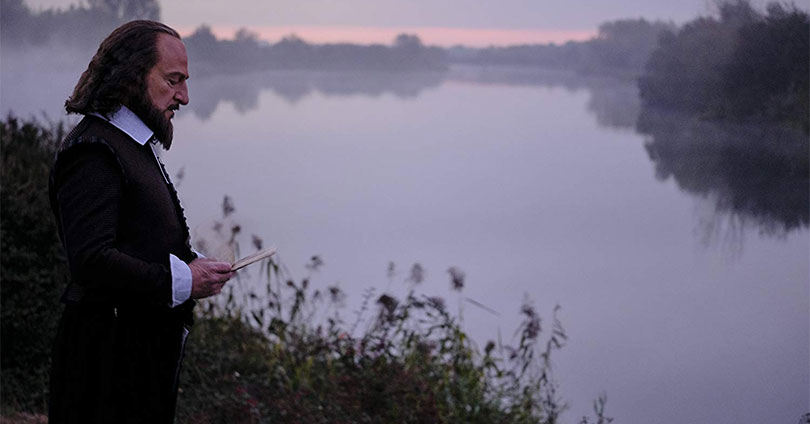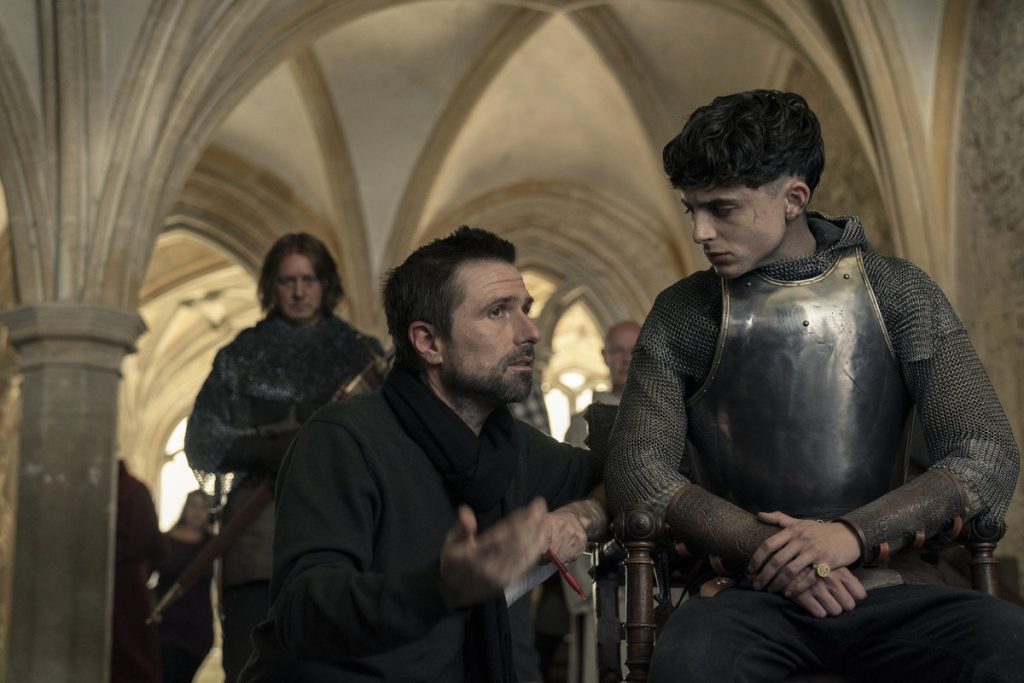Three feature films inspired by Shakespeare and his work – Kenneth Branagh’s All is True, Claire McCarthy’s Ophelia, and David Michôd’s The King – made fleeting theatrical appearances in Australian arthouse cinemas in 2019. While nothing to sniff at, the films serve to highlight that there’s much less cinematic Shakespeare nowadays – and conspicuously “less of” Shakespeare in Ophelia and The King – compared to the Shakespeare film boom of the 1990s.
Beginning in spirit with Branagh’s rousing Henry V in 1989, the 1990s saw a boom in Shakespeare on screen. Scholar Emma French (2006, p. 64) has labelled this period a “decade of unprecedented production of filmed Shakespeare adaptations”, and it’s hard to disagree. The era yielded Branagh’s cheerful Much Ado about Nothing and epic Hamlet, a juicy Othello starring Branagh and Laurence Fishburne, Mel Gibson in Martin Riggs mode and Glenn Close as a maternal femme fatale in Franco Zeffirelli’s Hamlet, Ian McKellen as a wartime dictator in Richard III and Al Pacino looking for Richard in the documentary of the same name, enjoyable star-studded versions of A Midsummer Night’s Dream and Twelfth Night, Baz Lurhmann’s iconic and energetic William Shakespeare’s Romeo + Juliet and a youthful update of The Taming of the Shrew in 10 Things I Hate about You, Anthony Hopkins hamming it up in Julie Taymor’s gruesome Titus, and the Oscar-winning romantic comedy Shakespeare in Love.
This deluge of Shakespeare feature films dried up over the subsequent two decades. According to IMDb, since 2015 Shakespeare’s name has graced over 200 productions. However, few of these are feature films: the majority are recordings or transmissions of stage performances by the likes of the Royal Shakespeare Company and National Theatre, telemovies, and short films or underground works from directors seizing on the Bard’s public domain status. There have been some notable feature film adaptations and derivations to be sure: Tim Blake Nelson’s high-school-set Othello, titled O; Branagh’s underseen As You Like It; Al Pacino as Shylock in The Merchant of Venice; Taymor’s The Tempest with Helen Mirren inhabiting the Prospero role; Ralph Fiennes’ militaristic Coriolanus; Ethan Hawke-starring updates of Hamlet and Cymbeline from Michael Almereyda; and—in perverse counterpoint to Shakespeare in Love—an entertaining cut of character assassination in Roland Emmerich’s bombastic Anonymous. However, no production made as big a splash as any of the major 1990s titles.
It is worth asking why there has been such a marked reduction in mainstream interest and investment in Shakespeare on screen. It is partly attributable to shifting film culture. While Shakespeare was a staple of 90s cinema, only William Shakespeare’s Romeo + Juliet and Shakespeare in Love were bona fide box office bonanzas, or “palpable hits” in Hamlet’s parlance. Moreover, Shakespeare films fit squarely into a mid-budget adult drama niche that is largely non-existent in this post-Marvel age, or has shifted predominantly to Netflix. Indeed, the streaming giant increasingly dictates what films remain in conversation and in circulation, and while The King is a Netflix production, there are few older Shakespeare titles currently available on the streaming platform, as the paltry offerings spotlighted in this piece Eight movie adaptations on Netflix to celebrate Shakespeare Day attest. Shakespeare out of sight, Shakespeare out of mind.
In addition to these industrial factors, this shift is also attributable to our shifting relationship with Shakespeare. In a provocative essay titled ‘The incredible shrinking Bard’, scholar Gary Taylor (1999, p. 197) argues that “Shakespeare’s reputation peaked in the reign of Queen Victoria, and is now shrinking”. Citing signs of waning cultural investment in Shakespeare, Taylor prophesises that “As long as the English language survives, people will be reading or listening to Shakespeare… But the number of people attending to Shakespeare, the intensity of their attention, the frequency and complexity of their appropriations, will inevitably diminish” (p. 205). He proposes that Shakespeare’s status will “collapse to the status of Chaucer… A great writer, admired by specialists, but paid little attention by the larger world” (p. 205). While the 200+ IMDb credits attached to Shakespeare from the past five years signal that Shakespeare still pervades entertainment, the fact none of these productions have generated near the attention of the key 90s productions lends some credence to Taylor’s hypothesis, at least cinematically speaking.

An alternative take is supplied by another scholar, Julie Sanders. In her book Adaptation and Appropriation, Sanders (2005, p. 45) notes that Shakespeare’s works are increasingly taking on the status of myths and fairy tales. This is certainly consistent with what Ophelia does with Hamlet and The King does with the Henriad plays (Henry IV, Parts I and II and Henry V): both films jettison their original play texts and weave in their own narrative inventions. While this is not novel, it is nonetheless striking to see these two similarly-minded, high-profile films released in such close proximity (at least in Australia; Ophelia first screened overseas in 2018), reinforcing that Shakespeare’s primary value in these works—and conceivably in many more films moving forward—is as a supplier of mythic material rather than a sacred source for filial adaptation.
In their scripting and development stages, the creative teams on both productions would in all probability have had a conversation about whether or not to utilise Shakespeare’s dialogue: whether “to keep or not to keep” that rich, dense, textured dialogue—vacuum-packed with character- and world-building poetry—even if to deploy only sparingly. Ultimately, both productions opted to jettison it. Shakespeare’s greatest gifts to readers and audiences were his dialogue and characterisation, and—not to put too fine a point on it—the dialogue is the characterisation: Hamlet is not Hamlet, and Ophelia not Ophelia, because of these characters’ actions, nor the plot they navigate (which, like most Shakespeare plays, was repurposed from precursor sources), nor the skeletal stage directions they enact. While jettisoning that dialogue and the characterisation baked into it is clearly designed to make the tales more palatable to contemporary audiences, it is also unquestionably a storytelling loss.
But both films take their swing. Ophelia decisively throws down the gauntlet in its opening narration—where Ophelia (portrayed by Star Wars star Daisy Ridley) states it is high time she take the reins of her own story—and subsequently proceeds to retell Hamlet from her point of view, tweaking events, characterisation, and ultimately her fate. This is not the first time Hamlet has been retold from the perspective of supporting players: Tom Stoppard did this to great comic effect in Rosencrantz and Guildenstern are Dead. But where Stoppard preserved some of Shakespeare’s play text, Ophelia jettisons it entirely, rewriting scenes from Hamlet in dialogue that has alternately been described by The Guardian’s Jordan Hoffman as “dumbed down to a generic Game of Thrones level” and Vulture’s David Edelstein as “respectable poetic banter”. Ophelia’s recalibration of Hamlet is also pointedly political: the film, like its source novel by Lisa Klein, is a work of feminist literary revisionism, with Ophelia transformed from a character crushed by male hegemony into an active agent in her own right. Given that twentieth century Shakespeare onscreen was largely associated with white male auteurism—as exemplified by British actor-directors Branagh and Laurence Olivier, Italy’s Franco Zeffirelli, and “difficult geniuses” and noted misogynists like Orson Welles and Roman Polanski, this levelling of the field is fitting in the post-MeToo era.
Ophelia director Claire McCarthy is Australian, as is The King director David Michôd, who previously helmed crime classic Animal Kingdom and gnarly post-apocalyptic thriller The Rover. These filmmakers are the latest in an emerging tradition of Australian directors tackling Shakespeare: Geoffrey Wright delivered an enjoyable Melbourne gangster version of Macbeth in 2006 and Justin Kurzel a grungy period version of the same play in 2015, while a film of Measure for Measure starring Hugo Weaving from the creative team behind Pawno coming in 2020. Like Ophelia, The King’s spin on its source material—condensing the Henriad plays into a single feature—is not without precedent: Orson Welles performed a similar feat in 1965’s Chimes of Midnight. Yet where Welles, like Stoppard, preserved Shakespearean dialogue, Michôd and co-writer Joel Edgerton opt not to; indeed, the Bard is not even credited as source author on The King’s IMDb page, reinforcing his status as mythic progenitor. As The King is a Netflix production and the platform dictates the direction of much contemporary film culture, if successful it may spawn further adaptations of the Bard and set the tone for said adaptations. However, if this Uproxx article obsessing on The King’s lead actors’ manes is anything to go by—“As Prince Hal … Timothée Chalamet chopped his long, floppy locks for a vaguely humiliating bowl cut. Meanwhile Robert Pattinson … rocks a stringy beach ’do. Who will win the Battle of Agincourt? And who will win the award for best hair?”—Shakespeare’s role in the success or failure of these undertakings is arguably negligible.
Two more 2019 films are worth highlighting here: Jon Favreau’s The Lion King remake, which earned over 1.6 billion dollars commercially—and earned more in its 37th day in American cinemas than All is True and Ophelia’s global earnings combined—and Steven Spielberg’s upcoming retread of West Side Story. Both are based on works somewhat indebted to Shakespeare: the former riffs loosely on Hamlet, the latter a bit more faithfully on Romeo and Juliet. While faithful mainstream feature film adaptations of Shakespeare’s plays are clearly perceived, to borrow a line from Hamlet, as “stale, weary, flat and unprofitable” and on a marked decline, and much is lost in the jettisoning of the Bard’s dialogue—to hijack a famous philosophical question, “If Shakespeare is adapted to film without any of his dialogue, is it Shakespeare?”—All is True, Ophelia, The King, The Lion King, and West Side Story nonetheless point to the plays and their author serving as a source for mythic material on screen. In this respect, Shakespeare continues to fulfil his contemporary Ben Johnson’s prophecy—that his work is “Not of an age, but for all time”—just minus all those pesky, ornate words.

References
French, Emma (2006). Selling Shakespeare to Hollywood: The marketing of filmed Shakespeare adaptations from 1989 into the new millennium. Hatfield: University of Hertfordshire Press.
Sanders, Julie (2005). Adaptation and Appropriation. New York: Routledge.
Taylor, Gary (1999). Afterword: The incredible shrinking Bard. In Christy Desmet & Robert Sawyer (eds), Shakespeare and Appropriation (pp. 197-205). London: Routledge.



